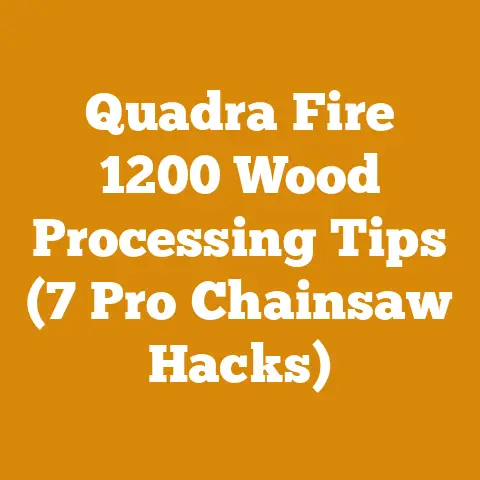Chainsaw Pitch and Gauge (5 Essential Tree Cutting Tips)
Alright, let’s dive into the fascinating world of chainsaws, specifically focusing on pitch and gauge, and how understanding these essential elements can not only improve your tree cutting but also impact your budget. We’ll also explore cost-effective firewood preparation.
Chainsaw Pitch and Gauge: 5 Essential Tree Cutting Tips (and How They Affect Your Wallet)
The crisp autumn air, the smell of freshly cut wood – there’s something deeply satisfying about preparing your own firewood. For years, I relied on a local supplier, but the rising prices, and frankly, the inconsistent quality, pushed me to take matters into my own hands. Initially, I thought, “How hard can it be?” I quickly learned that a well-maintained chainsaw, suited to the task at hand, is crucial. And that’s where understanding pitch and gauge becomes paramount. This isn’t just about cutting wood; it’s about efficiency, safety, and ultimately, saving money.
1. Understanding Chainsaw Pitch: The Bite of the Blade
Chainsaw pitch refers to the spacing between the rivets on the drive links of your chain. It’s measured in inches, and the most common sizes are 3/8″, .325″, and .404″. Think of pitch as the “bite” your chainsaw takes with each revolution.
- 3/8″ Pitch: This is a versatile pitch, often found on smaller to mid-sized chainsaws. It’s a good all-around choice for limbing, felling smaller trees, and general firewood preparation. Its smaller bite means it requires less power, making it ideal for saws with smaller engines.
- .325″ Pitch: A step down in size from 3/8″, the .325″ pitch is common on mid-sized chainsaws. It offers a balance between cutting speed and power requirements. It’s a good option for users who want a bit more speed than the 3/8″ pitch provides, but still need manageable power.
- .404″ Pitch: This is the big boy of the pitch world. It’s found on larger, more powerful chainsaws and is designed for felling large trees and heavy-duty logging. This pitch takes a larger bite, requiring significantly more power.
Why does pitch matter for your budget?
Choosing the right pitch for your chainsaw and the wood you’re cutting directly impacts fuel consumption and chain wear. A smaller chainsaw with a .404″ pitch, for example, will struggle, leading to increased fuel consumption, slower cutting speeds, and premature wear on both the chain and the saw’s engine. This translates to higher fuel costs and more frequent chain replacements. On the other hand, using a small 3/8″ pitch chainsaw to fell large trees will take an eternity, also wasting time and fuel.
Cost Implications:
- Fuel Consumption: A mismatched pitch can increase fuel consumption by as much as 20-30%. Consider that the average price of gasoline used for chainsaws is about $4.50 per gallon (as of late 2024 – prices fluctuate, so always check your local rates). An extra 20% translates to almost an extra dollar per gallon. Over a season of cutting firewood, that adds up!
- Chain Replacement: For example, a good quality chainsaw chain might cost $30-$60, and if you are using the wrong pitch for your chainsaw, you may have to replace the chain more often, maybe twice as often.
- Chainsaw Longevity: Overworking a chainsaw by using the wrong chain can reduce its lifespan, potentially leading to costly repairs or premature replacement.
Tip: Match the pitch of your chain to the recommended pitch for your chainsaw model. Consult your owner’s manual for guidance.
2. Gauge: The Thickness That Matters
Gauge refers to the thickness of the drive links on your chainsaw chain, specifically the part that fits into the guide bar groove. Common gauges are .043″, .050″, .058″, and .063″. Think of gauge as how snugly the chain fits into the bar.
- .043″ Gauge: This is a thinner gauge, typically found on smaller, lighter-duty chainsaws.
- .050″ Gauge: This is the most common gauge, used on a wide range of chainsaws, from smaller homeowner models to larger professional saws.
- .058″ Gauge: A slightly thicker gauge, often found on mid-sized to larger chainsaws.
- .063″ Gauge: The thickest gauge, typically found on larger, more powerful chainsaws designed for heavy-duty work.
Why does gauge matter for your budget?
Using the wrong gauge chain can be dangerous and damaging to your chainsaw. If the gauge is too thin, the chain will not fit snugly in the guide bar groove, leading to increased vibration, poor cutting performance, and potential derailment. If the gauge is too thick, the chain will not fit at all.
Cost Implications:
- Guide Bar Wear: Using the wrong gauge can cause excessive wear on the guide bar, requiring premature replacement. A new guide bar can cost anywhere from $30 to $100, depending on the size and quality.
- Chain Derailment: A chain that is too loose can derail, causing damage to the chain, the chainsaw, and potentially, yourself.
- Increased Vibration: Incorrect gauge can cause more vibration which can lead to operator fatigue and increased risk of injury.
Tip: Always use the correct gauge chain for your chainsaw and guide bar. The gauge is usually stamped on the guide bar itself.
3. Matching Pitch and Gauge to Your Wood Type
The type of wood you’re cutting also plays a significant role in choosing the right pitch and gauge, and ultimately, impacting your costs. Different wood species have varying densities and hardness, requiring different levels of cutting power and chain durability.
- Softwoods (Pine, Fir, Spruce): These woods are easier to cut and require less power. A smaller pitch (like 3/8″ or .325″) and a thinner gauge (like .050″) will generally suffice.
- Hardwoods (Oak, Maple, Hickory): These woods are denser and harder to cut, requiring more power and a more robust chain. A larger pitch (like .404″) and a thicker gauge (like .058″ or .063″) may be necessary.
Cost Implications:
- Chain Sharpening: Cutting hardwoods with a chain designed for softwoods will dull the chain much faster, requiring more frequent sharpening. Sharpening your own chain can save money, but requires time and skill. Paying a professional to sharpen your chain typically costs around $10-$15 per chain.
- Chain Breakage: Using the wrong chain for the wood type can lead to chain breakage, which is both dangerous and costly.
Tip: Consider the type of wood you’ll be cutting most often when choosing your chainsaw and chain. If you cut a variety of wood types, consider having multiple chains with different pitches and gauges.
4. Chain Maintenance: Sharpening and Lubrication
Proper chain maintenance is crucial for maximizing cutting efficiency, extending chain life, and reducing overall costs. Two key aspects of chain maintenance are sharpening and lubrication.
- Chain Sharpening: A sharp chain cuts faster, requires less effort, and is safer to use. Dull chains can “kickback” more easily, increasing the risk of injury.
- Chain Lubrication: Proper lubrication reduces friction between the chain and the guide bar, preventing overheating and wear.
Cost Implications:
- Reduced Cutting Time: A sharp chain can significantly reduce cutting time, saving you time and fuel.
- Extended Chain Life: Regular sharpening and lubrication can extend the life of your chain, reducing the frequency of replacements.
- Reduced Chainsaw Wear: Proper lubrication also reduces wear on the chainsaw’s engine and other components.
Personal Experience: I learned this lesson the hard way. I initially neglected chain maintenance, figuring “it’s just wood.” But I quickly realized that a dull chain not only made cutting harder but also put a strain on my chainsaw. I started sharpening my chains regularly and using a high-quality bar and chain oil. The difference was remarkable – my cutting time was cut in half, and my chains lasted much longer.
Cost Breakdown:
- Chain Sharpening Tools: A basic chainsaw sharpening kit can cost around $30-$50.
- Bar and Chain Oil: A gallon of high-quality bar and chain oil typically costs around $20-$30.
- Professional Sharpening: As mentioned earlier, professional sharpening costs around $10-$15 per chain.
Tip: Invest in a good quality chainsaw sharpening kit and learn how to sharpen your own chains. This will save you money in the long run. Also, always use a high-quality bar and chain oil to keep your chain properly lubricated.
5. The Importance of Proper Tension
Maintaining proper chain tension is crucial for safe and efficient cutting. Too loose, and the chain can derail. Too tight, and it can bind, overheat, and wear out prematurely.
Why does tension matter for your budget?
Improper chain tension can lead to a variety of problems, including:
- Chain Derailment: A loose chain is more likely to derail, causing damage to the chain, the chainsaw, and potentially, yourself.
- Guide Bar Wear: A loose chain can also cause excessive wear on the guide bar.
- Chain Breakage: A chain that is too tight can overheat and break.
Cost Implications:
- Guide Bar Replacement: As mentioned earlier, a new guide bar can cost anywhere from $30 to $100.
- Chain Replacement: Chain replacement can cost $30-$60.
- Safety: Beyond the monetary costs, there are serious injury risks from a chain that breaks and comes off the guide bar.
Tip: Check chain tension regularly, especially when the chain is new. The chain should be snug against the guide bar, but you should still be able to pull it around the bar by hand.
1. Sourcing the Wood:
This is often the biggest cost factor. You have several options:
- Free Wood: This is the holy grail! Look for downed trees on your property, or contact local tree services to see if they have any wood they’re willing to give away.
- Permitted Cutting on Public Land: Many national forests and state lands allow you to cut firewood for personal use, but you’ll need a permit. Permit costs vary widely. For example, in some areas, a permit for a few cords might cost as little as $20, while in other areas, it could be closer to $100.
- Buying Logs: You can purchase logs from a logging company or sawmill. Prices vary depending on the species, size, and quality of the logs.
- Buying Green Firewood: This is firewood that hasn’t been seasoned (dried). It’s typically cheaper than seasoned firewood, but you’ll need to dry it yourself.
- Buying Seasoned Firewood: This is the most expensive option, but it’s ready to burn immediately.
Cost Breakdown (Based on Average Prices in Late 2024):
- Free Wood: $0 (but requires your time and effort)
- Permitted Cutting: $20-$100 per permit (depending on location and quantity)
- Logs: $50-$150 per cord (depending on species and quality)
- Green Firewood: $100-$200 per cord (depending on species and location)
- Seasoned Firewood: $200-$400 per cord (depending on species and location)
Factors Affecting Wood Prices:
- Species: Hardwoods like oak and maple are generally more expensive than softwoods like pine and fir.
- Location: Firewood prices vary significantly depending on location. Areas with abundant forests tend to have lower prices.
- Season: Firewood prices tend to be higher in the fall and winter, when demand is highest.
- Delivery: If you need the wood delivered, that will add to the cost.
2. Tool Costs:
We’ve already discussed chainsaw costs in detail. Here are some other tools you might need:
- Axe or Maul: For splitting wood. A good quality axe or maul can cost around $50-$100.
- Splitting Wedge: For splitting particularly tough logs. A splitting wedge costs around $20-$30.
- Sledgehammer: To drive the splitting wedge. A sledgehammer costs around $30-$50.
- Log Splitter: A powered log splitter can significantly reduce the amount of time and effort required to split wood. Rental costs vary depending on the size and type of splitter. You can rent a gas-powered log splitter for around $50-$100 per day. Purchasing a log splitter can cost anywhere from $500 for a small electric model to several thousand dollars for a large gas-powered model.
- Safety Gear: Safety glasses, gloves, ear protection, and sturdy boots are essential. Budget around $50-$100 for safety gear.
- Measuring Tools: A measuring tape and a marking crayon or paint are needed to cut logs to the desired length.
Cost Breakdown:
- Axe/Maul: $50-$100
- Splitting Wedge: $20-$30
- Sledgehammer: $30-$50
- Log Splitter Rental: $50-$100 per day
- Log Splitter Purchase: $500 – $5000+
- Safety Gear: $50-$100
- Measuring Tools: $10-$20
3. Labor Costs:
If you’re doing all the work yourself, your labor is “free” (but it’s still valuable time!). If you’re hiring someone to help you, you’ll need to factor in labor costs. Labor rates vary depending on the location and the experience of the worker. Expect to pay around $15-$30 per hour for manual labor.
Cost Breakdown:
- Your Labor: Priceless (but time is money!)
- Hired Labor: $15-$30 per hour
4. Drying and Storage:
Firewood needs to be properly dried (seasoned) before it can be burned efficiently. This typically takes 6-12 months. You’ll need a place to store the wood, preferably off the ground and under cover.
Cost Implications:
- Storage Area: You may need to build or purchase a woodshed or other storage structure. A simple woodshed can be built for a few hundred dollars.
- Tarp: A tarp can be used to cover the wood and protect it from rain and snow. A good quality tarp costs around $20-$50.
- Wood Rack: These can be purchased to keep wood off the ground, promoting air circulation and faster drying.
Cost Breakdown:
- Woodshed: $200+
- Tarp: $20-$50
- Wood Rack: $50-$150
5. Permits and Regulations:
Depending on your location, you may need permits to cut wood on public land or to burn firewood in your home. Check with your local authorities for regulations.
Cost Breakdown:
- Permits: Variable, depending on location and activity.
Case Study: My Firewood Project Budget
Let’s break down my own recent firewood preparation project to illustrate how these costs can add up. I decided to cut and split 3 cords of oak from a fallen tree on my property.
- Wood Source: Free (fallen tree) – $0
- Chainsaw Maintenance: $20 (bar and chain oil, sharpening)
- Axe/Maul: Already owned – $0
- Splitting Wedge/Sledgehammer: Already owned – $0
- Safety Gear: Already owned – $0
- Labor: My own time (estimated 40 hours) – $0 (but significant time investment)
- Storage: Existing woodshed – $0
Total Cost: $20
However, this doesn’t factor in the value of my time. If I had paid someone $20 per hour to do the work, the labor cost would have been $800.
Alternative Scenario: Buying Seasoned Firewood
If I had purchased 3 cords of seasoned oak firewood, it would have cost me around $300 per cord, for a total of $900.
Conclusion:
In my case, cutting my own firewood saved me a significant amount of money, but it required a substantial time investment. The best option for you will depend on your individual circumstances, including your access to wood, your available time, and your budget.
Practical Tips for Cost Optimization:
- Source Wood for Free: Look for downed trees on your property or contact local tree services.
- Cut and Split Your Own Wood: This is the most labor-intensive option, but it can save you a lot of money.
- Season Your Own Firewood: Buy green firewood and dry it yourself.
- Maintain Your Tools: Regular maintenance will extend the life of your tools and reduce repair costs.
- Sharpen Your Own Chains: This will save you money on professional sharpening.
- Buy in Bulk: If you’re buying firewood, buy it in bulk to get a better price.
- Shop Around: Compare prices from different suppliers.
- Consider Alternative Fuels: If firewood prices are too high, consider alternative fuels like wood pellets or propane.
Final Thoughts
Preparing your own firewood can be a rewarding and cost-effective way to heat your home. By understanding the factors that affect firewood costs and implementing these cost-saving tips, you can enjoy the warmth of a wood fire without breaking the bank.






